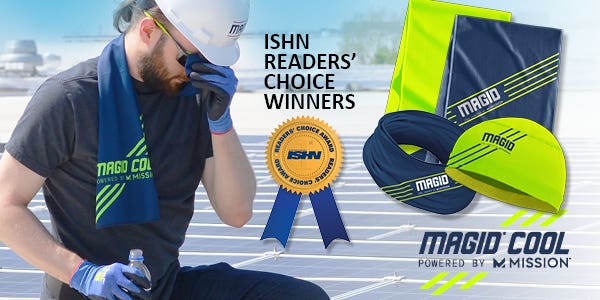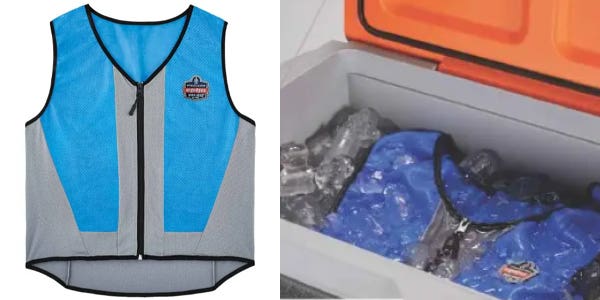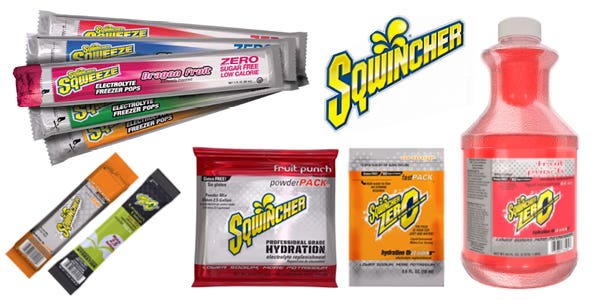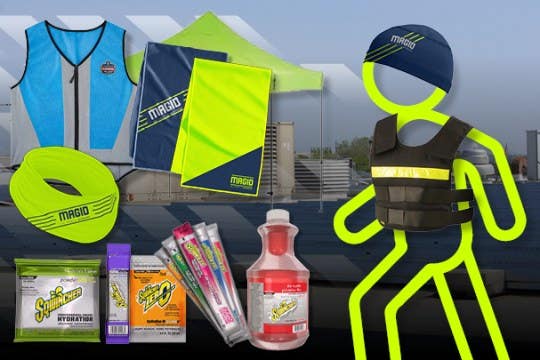
Build a Better Cooling Station for Heat Safety
By John Heniff, Safety Writer, Magid


Getting workers out of the heat is imperative to prevent overheating on the job and to help them recover from prolonged heat exposure. To reduce thermal strain and heat-related illness, heat safety experts recommend designating a cooling station near all work areas as part of a comprehensive heat protection plan. But is your cooling station doing all it can to keep workers safe? Even if you have a location set up and ready to go, you can always improve based on the latest recommendations from safety experts at Magid!


Pro:
The latest cooling garments activate with any temperature of water to cool as low as 30 degrees below normal body temperature. They stay cool for up to two hours, can be reactivated for renewed cooling, and are available in bandanas, skull caps, neck gaiters/face covers, and towels. They can be used at breaktime or even during the job for fast and continous refreshment since they’re so easy to use. Note that cooling garments should cover as much body surface area as possible to promote optimal cooling capacity.
Con:
Some older and lower-quality models can become warm in a very short amount of time (especially in elevated temperatures), feel slimy to wear, or only feel as cool as the water it’s soaked in.
Be sure you’re getting the latest technology in HydroActive™ Cooling PPE like Magid® Cool Powered by Mission®.


☑ AIR CONDITIONERS
Pro:
If electrical outlets are available, air-conditioning units can cool down overheated workers without forcing them to remove their PPE.
Con:
Since it requires an enclosed space to create a cool area, air-conditioning units cannot be installed in outdoor work environments.


☑ REFRIGERATORS
Pro:
Refrigerators of any size stocked with cool water and electrolyte-replacing beverages have significant value to help keep workers hydrated throughout the day. You can also use them to keep vest inserts and towels cold.
Con:
Like air-conditioning units, refrigerators cannot be used in outdoor jobsites that don’t have access to electrical outlets.


Pro:
Conductive/phase change cooling vests are made with large pockets for a replaceable coolant like an ice pack to aid in passive cooling of the worker’s torso. This design makes the vest portable and effective in any environment, from landscaping or construction sites near buildings to more remote areas in forests or deserts. While useful in body cooling stations, your workers can bring them on the job for continuous refreshment, too.
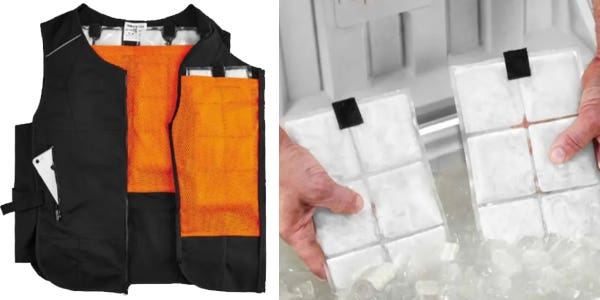

Con:
The ice packs or cooling products can feel heavy to wear and be prone to melting due to direct sunlight, heat, and humidity. If the vests have lost thier cooling potential, workers will carry a heavier load with no cooling benefit. Additionally, although these items do help to lower core temperatures, workers may feel like the vests are not cooling them as well as other items do and complain that they’re not refreshing. Conductive/phase change cooling vests do not hold their temperature for much time, either.


Pro:
Evaporative vests are useful if your team operates in hot environments with low humidity. The vest’s fabric carries heat away from the body through the evaporation process and can be less expensive than a conductive/phase change cooling vest, too. While useful in body cooling stations, your workers can bring them on the job for continuous refreshment, too.
Con:
Early research in occupational settings suggests evaporative vests are not as effective for cooling compared to conductive/phase change cooling vests. Evaporative vests are not as effective in high humidity environments because the abundance of moisture in the air slows the evaporation and cooling process. Evaporative vests also need to be soaked in cool water, too.


☑ FANS & SHADE
Pro:
Mist-fans, portable evaporative coolers, and regular fans can be personalized, transportable, and more cost-efficient than an air-conditioning unit. You can buy a larger fan that can cool a larger area and pop-up utility tents can also provide shade for a specific area, too.
Con:
Their use is limited by size as smaller fans can only effectively cool a handful of people at a time. And like air-conditioning units and refrigerators, their use can be limited based on access to electricity. At temperatures over 104⁰ F, fans can also become detrimental to cooling, too.


☑ COLD, WET TOWELS
Pro:
Even if workers can only partially remove their PPE, cold, wet towels can still provide relief at a low cost.
Con:
Cold wet towels need to be prepared and kept cold before use, don’t cool large areas of the body, and can be difficult to wear under PPE. They also need to be rotated after 1-2 minutes so workers can get the most cooling potential out of them. One study found that towels that were not rotated after 1-2 minutes became warmer and kept core temperatures the same or made them even warmer than before.


Pro:
Providing workers with ice slushies to drink can help them stay hydrated, doesn’t require full removal of their PPE, and is easy to put together with just water, ice, and a cooler for storage.
Con:
The cooler containing the slushies needs to be able to stay cold. Additionally, consuming them during non-rest periods can hinder a worker’s sweat response.


☑ EXTREMITY IMMERSION CONTAINERS
Pro:
Extremity immersion (dipping hands or arms into ice water) can be done with a container the size of a water cooler and was shown to lower core temperature and heart rate in academic research. Workers can also keep PPE like their hard hats and safety vests on while they cool their hands or forearms. Note that extremity immersion is not a remedy for heat stroke and that whole body cold water immersion is the recommended procedure.
Con:
Extremity immersion requires water that is cold to deliver the highest cooling rate. Extremity immersion containers are usually expensive and individualized where only one or two people can use it at a time, too.


☑ WATER BOTTLES/HOSES/SHOWERS FOR WATER DOUSING
Pro:
A cool water source such as a water bottle, hose, or a shower can be used to help workers wet their skin and cool down. A 2019 study found that water dousing reduced thermal and cardiovascular strain in hot and humid conditions as well as hot and dry conditions, too.
Con:
Water dousing may require the removal of certain PPE items because it can make the garments wet and uncomfortable to wear.


☑ WHOLE BODY COLD WATER IMMERSION TUBS
Whole body cold water immersion is a process used to cool a worker suffering from exertional heat stroke in the quickest way possible. After contacting EMTs, the method involves placing a worker in a 100–150-gallon tub filled with ice and water that is being stirred and replaced every few minutes. This is designed to cool the sufferer’s body temperature down to at least 102⁰ Fahrenheit within 30 minutes to avoid permanent cell damage or death. Remember to assign someone to stay with the ill worker at all times and continually check them for signs of additional distress while waiting for EMTs.
Pro:
Whole body cold water immersion is considered the top choice for treating workers suffering from exertional heat stroke and is backed by expert observation and scientific evidence.
Con:
Whole body cold water immersion is unlikely to be used in rest periods because of its recommended use in emergency situations, but your cooling station is an ideal place to keep emergency gear so everyone on your job site knows where it is if it’s needed. Whole body cold water immersion tubs are also difficult to use in remote settings and are extremely difficult and time-consuming to use in general.
If an immersion tub is impossible or impractical, you can create a makeshift immersion tub by placing the victim in the center of a tarp and lifting the sides to make a sling. Fill the sling with ice and cold water to cool them as well as possible while you wait for EMTs.
COOLING STATIONS FOR DIFFERENT TYPES OF JOBSITES
Now that you know the pros and cons of different cooling methods, use this handy guide to determine the best cooling station options for you and your workers.
| If Workers Can Remove Their PPE and Have Access to Power | If Workers Have No Access to Power but Can Remove Their PPE | If Workers Can’t Remove Their PPE but Have Access to Power | If Workers Can’t Remove Their PPE and Have No Access to Power | |
| Air-conditioning | X | X | ||
| Mist-fans/cooling fans | X | X | ||
| Evaporative vests | X | X | ||
| Conductive/phase change cooling vests | X | X | X | X |
| Cold wet towels | X | X | X | X |
| Ice slushy ingestion | X | X | ||
| Extremity immersion | X | |||
| Water dousing | X | X | ||
| Cool water and electrolyte-replacing beverages | X | X | X | X |
| Body-cooling PPE | X | X | X | X |


Check out our Heat Illness Prevention HQ to start preparing your heat safety plan!
